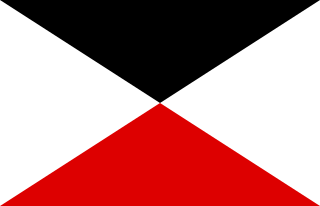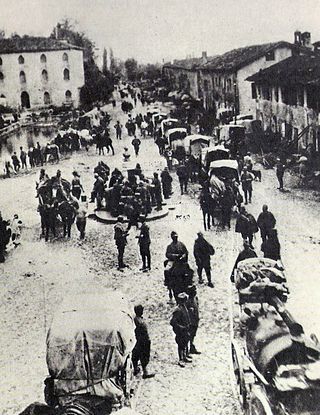
The Guards Corps/GK was a corps level command of the Prussian and then the Imperial German Armies from the 19th century to World War I.

The IV Army Corps / IV AK was a corps level command of the Prussian and then the Imperial German Armies from the 19th Century to World War I.
The Bavarian Ersatz Division was a Bavarian division of the Imperial German Army in World War I. It was formed in August 1914 and dissolved on 6 October 1918. It was initially a Bavarian formation but soon received several non-Bavarian units which served with the division until 1917.

The 1st Landwehr Division was an infantry division of the Imperial German Army during World War I. It was formed on the mobilization of the German Army in August 1914 under the "Higher Landwehr Commander 1" and, initially, also referred to as the "Landwehr-Division Goltz" after its commander. The Landwehr was the third category of the German Army, after the regular Army and the reserves. Thus Landwehr divisions were made up of older soldiers who had passed from the reserves, and were intended primarily for occupation and security duties rather than heavy combat.
The 35th Reserve Division was a unit of the Imperial German Army in World War I. The division was formed on the mobilization of the German Army in August 1914. The division was disbanded during the demobilization of the German Army after World War I. The division began the war as part of the central reserve of Fortress Thorn. Although designated a reserve division, initially, it was primarily composed of Landwehr units. In 1916, it was completely reorganized, receiving new brigade headquarters and newly formed regiments.
The 19th Ersatz Division was a unit of the German Army, in World War I. The division was formed on the mobilization of the German Army in August 1914. The division was disbanded in 1919, during the demobilization of the German Army after World War I.

The 3rd Landwehr Division was an infantry division of the Imperial German Army during World War I. It was formed on the mobilization of the German Army in August 1914 under the "Higher Landwehr Commander 3". The Landwehr was the third category of the German Army, after the regular Army and the reserves. Thus Landwehr divisions were made up of older soldiers who had passed from the reserves, and were intended primarily for occupation and security duties rather than heavy combat. While the division was a Landwehr formation, at the beginning of the war it also had an attached Ersatz infantry brigade, made up of cadres from various regimental replacement battalions. The division was primarily raised in the Prussian provinces of Posen, Lower Silesia, and West Prussia. The division was disbanded in 1919 during the demobilization of the German Army after World War I.

The 4th Landwehr Division was an infantry division of the Imperial German Army during World War I. It was formed on mobilization of the German Army in August 1914 under the "Higher Landwehr Commander 4". The Landwehr was the third category of the German Army, after the regular Army and the reserves. Thus Landwehr divisions were made up of older soldiers who had passed from the reserves, and were intended primarily for occupation and security duties rather than heavy combat. The division was primarily raised in the Prussian provinces of Upper and Lower Silesia. It was disbanded in 1919 during the demobilization of the German Army after World War I.
The 83rd Infantry Division was a formation of the Imperial German Army in World War I. The division was formed in November 1914 as the "Division Posen 1", part of the Posen Corps, and became the 83rd Infantry Division in June 1915. It was initially formed from the garrison infantry regiments of Fortress Posen. The division was disbanded in 1919 during the demobilization of the German Army after World War I.
The 87th Infantry Division was a formation of the Imperial German Army in World War I. The division was formed in February 1915 as the provisional Dickhuth Corps, named after its commander, and became the 87th Infantry Division in August 1915. The division was disbanded in 1919 during the demobilization of the German Army after World War I.
The 89th Infantry Division was a formation of the Imperial German Army in World War I. The division was formed in November 1914 as the provisional Westernhagen Division, named after its commander. The nucleus of the unit was troops collected at Posen. It became the 89th Infantry Division in August 1915. The division was disbanded in 1919 during the demobilization of the German Army after World War I.
The 1st Bavarian Landwehr Division was a unit of the Bavarian Army, part of the Imperial German Army, in World War I. The division was formed on August 21, 1914, as the "Reinforced Bavarian Landwehr Division" and was also known initially as the Wening Division, named after its commander, Otto Wening. It became the 1st Bavarian Landwehr Division in September 1914. The division was disbanded in 1919 during the demobilization of the German Army after World War I.
This is the German Army order of battle on the outbreak of World War I in August 1914.

The 4th Cavalry Division was a unit of the German Army in World War I. The division was formed on the mobilization of the German Army in August 1914. The division was disbanded in 1919 during the demobilization of the German Army after World War I.
The history of the German Cavalry in World War I is one of an arm in decline.

The XXXVIII Reserve Corps was a corps level command of the German Army in World War I.

The X Reserve Corps was a corps level command of the German Army in World War I.

The Ersatz Corps was a corps level command of the German Army that existed briefly at the beginning of World War I.

The Battle of Caporetto, took place from 24 October to 19 November 1917, near the town of Kobarid, on the Austro-Italian front of World War I. The battle was named after the Italian name of the town of Kobarid.




